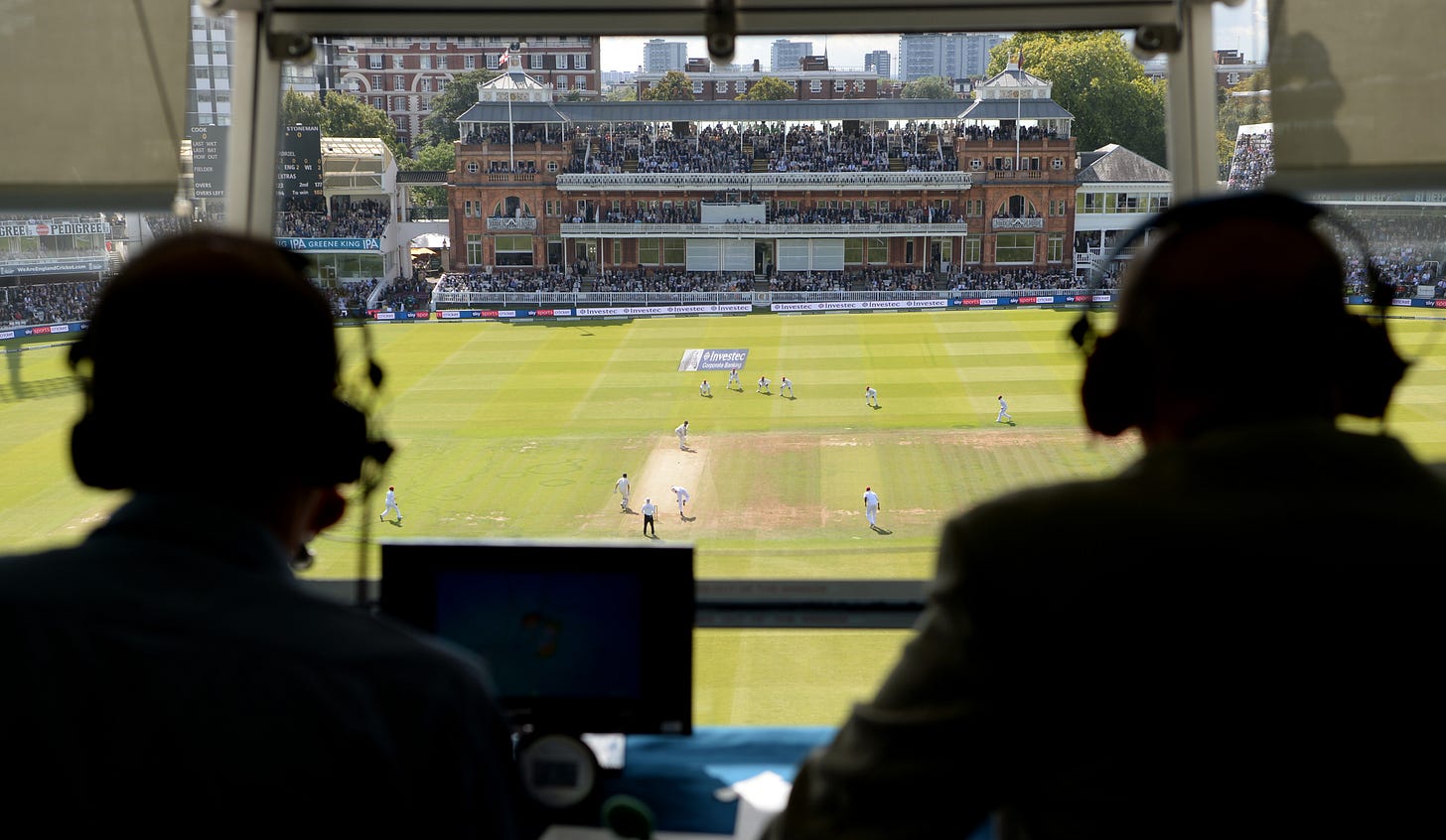Mic'd up, but Tuned Out
A rant on the poor standards of commentary we are made to go through
For half an hour today morning, between 7:45 and 8:15 am, Vivek Razdan and Murali Kartik dissected Ravichandran Ashwin's bowling. They were on Sony's Hindi commentary duties for the ongoing Test match between India and Australia.
Ashwin has had a middling match. To their credit, Australia's top-order batsmen have played him better than in the last two games. His flight and bounce variations haven't fetched him the success that a depleted Indian bowling attack would've hoped for. Focusing the spotlight on him made sense from a commentary perspective.
But what Razdan and Kartik did right, and it will stay long in my memory, is that they actually dissected his bowling and not the result. They told us things that, in a way, only ex-cricketers and keen observers can notice. Kartik spoke about the importance of core and lower-body strength for long spells; Razdan spoke through slow-motion replays to illustrate how Ashwin's follow-through was stopping short. They laced this analysis with further discussion about hip-drives and arm-whips.
After that thirty-minute stint, I knew more about cricket than I did before.
The lack of precisely that is a sore joint for most cricket commentary that we hear today. Had I been listening to the English commentary, I would've heard things about the Sydney Harbour, Virat Kohli, and how '90s cricket was better. I wish that statement was a gross generalisation, but it is not.
Throughout this series, and much of the last few years, most commentators are happy with just telling us that the sky is blue. Just yesterday, Harsha Bhogle, a commentator I think the world of, said this - "I have a feeling that Ravindra Jadeja would want to be on the field if he could."
I have some sympathy for Harsha - objectively, I promise - because of the rap on the knuckles he got from the BCCI a few years back. He is a master storyteller, a wordsmith cricket just hasn't valued enough, who didn't back down from keeping it real. The petulance of the current generation of cricketers has contributed to building an environment where criticism - from a job made to critique - is considered an overreach. Say nice things, speak about cricket's greatness, and take your cheque, thank you very much.
But I don't have any sympathy beyond that. If some doors are bolted, there are more than enough that are wide open. Harsha and the rest of the commentary panel know far more about the sport than most viewers put together. They often suffer from either a lack of preparation, or complete blindness to consumer experience, or most times, both.
On the Fox Sports broadcast the other day, Shane Warne got frustrated with Marnus Labuschagne's fidgety antics and blurted out "Just fucking bat properly." Andrew Symonds made another comment about Attention Deficit Disorder. Warne has 708 Test wickets and a serious claim as the greatest ever spinner to have held a cricket ball; Symonds has two World Cup gold medals.

He was reprimanded for his language. Soon after this match is over, Warne will apologise on social media for using the f-word and vow to learn from it. The cricket world will soon forget this episode, as they should because it is indeed a minor blip.
Warne's worst hours on this Indian tour has nothing to do with expletives, though. In November, during the first ODI match, Warne and Adam Gilchrist - two gems of international cricket - spent close to three minutes passing condolences to Navdeep Saini's family for his father's demise. Amarjeet Saini - Navdeep's father - was probably listening to this on TV with raised eyebrows and a gaping mouth, because the commentators got the bowler wrong. Mohammed Siraj had lost his father a couple of days before the tour began, not Saini.
A month later, Warne and his mates spent much time talking about Cheteshwar Pujara's Yorkshire nickname of Steve - showing a complete lack of respect for many things. For starters, Pujara is an international cricketer, so getting his name right should be part of your job. Secondly, there has been an extensive racism issue that has come out of Yorkshire's cricket team. In that context, calling him by an English nickname, which Pujara has confessed to not being a fan of, shows the commentators in dim light.

A clear root for the problem of preparation lies in the kind of commentary panel most broadcasters choose. Ex-cricketers, especially good ones, get a free pass. They just chit-chat on air for 2 hours in a day and leave in a plush, chauffeur-driven car when play finishes. Some even get a column in local newspapers.
Of course, there are exceptions to this from both Harsha and Warne's corner of the cricket ecosystem. Past greats like Ian Bishop, Nasser Hussain, and Michael Atherton are a favourite of cricket watchers for their preparation and detail levels. They talk about foot movement and stance, about heads falling over and ball release points. Harsha, himself, has been a beacon of sustained success in an environment that doesn't encourage non-cricketers. Through the 90s and 2000s, he was the commentator I would wait for because he told us a story beyond the pictures. Remember that passage after Sachin played his final Test?
It is terrible to see such little value put on such an essential part of sports broadcast. For the home viewer, a commentator is like a window. When the person with the mic brings the experience of thirty years of broadcasting or a thousand international wickets, you expect them to bring you closer to the game. You want them to tell you the little secrets of the sport only their kind would know.
When you instead get things like "Jadeja would have been on the field if he could", it is an equal insult to their career and the viewer.


